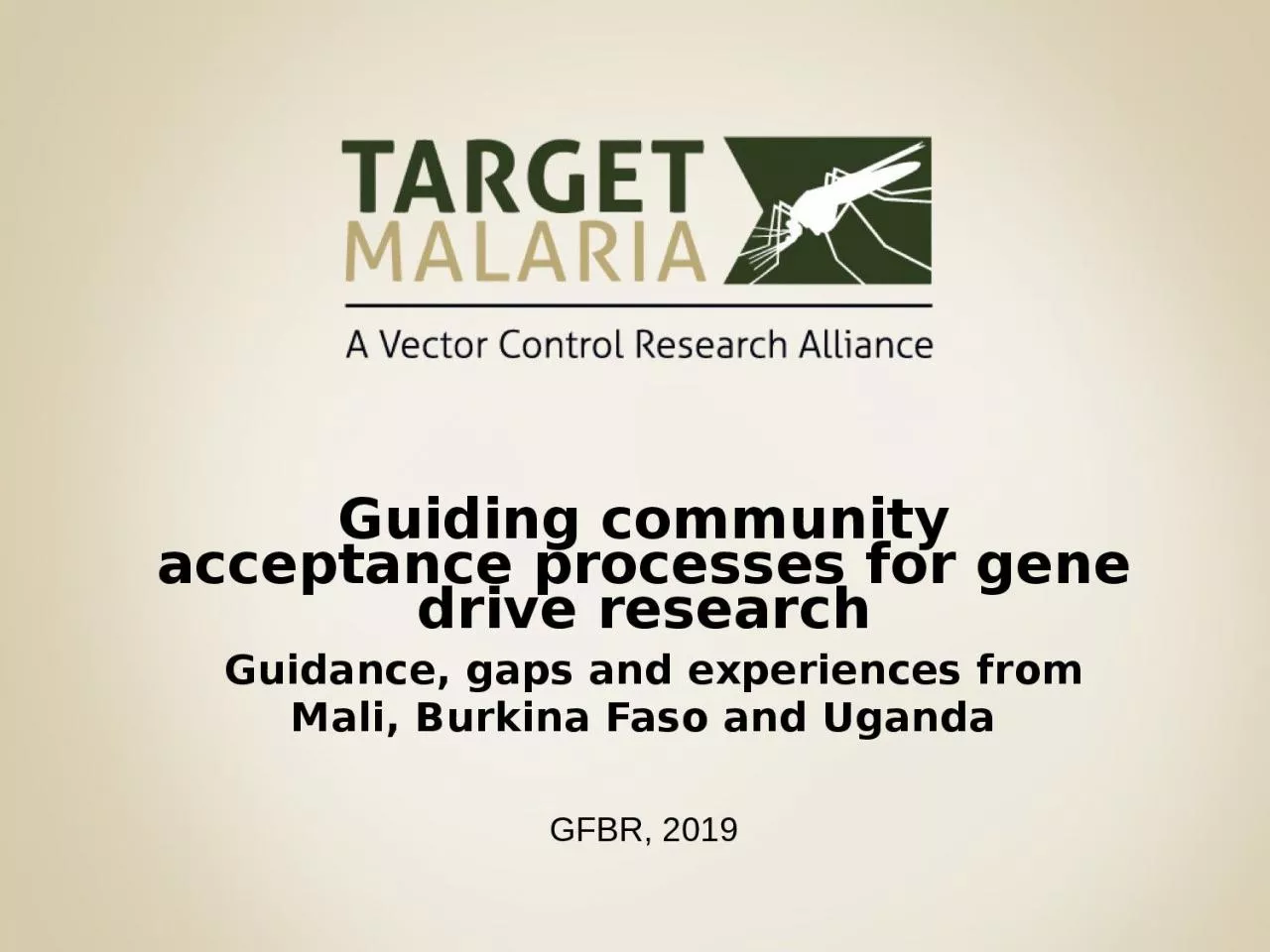

Guidance gaps and experiences from Mali Burkina Faso and Uganda GFBR 2019 The need for new tools Projected geographical distribution of Plasmodium falciparum malaria under the Accelerate 2 scenario between 2015 and 2030 Griffin ID: 932812
Download Presentation The PPT/PDF document "Guiding community acceptance processes f..." is the property of its rightful owner. Permission is granted to download and print the materials on this web site for personal, non-commercial use only, and to display it on your personal computer provided you do not modify the materials and that you retain all copyright notices contained in the materials. By downloading content from our website, you accept the terms of this agreement.
Slide1
Guiding community acceptance processes for gene drive research
Guidance, gaps and experiences from Mali, Burkina Faso and Uganda
GFBR, 2019
Slide2The need for new tools
Projected geographical distribution of
Plasmodium falciparum
malaria under the Accelerate 2 scenario between 2015 and 2030 (Griffin et al., 2016).
The recent report from the Lancet Commission on Malaria Eradication confirmed the need for new tool to achieve this objective calling for continuous R&D and mentioning gene drive as one potential tool
We need
new tools
to eradicate this disease and reach the SDG goals and countries commitments
9 Billion USD vs 3.1 currently available
Slide3What can be targeted?
Goal to reduce malaria transmission
Human biting rate
Per-bite infectivity rates
Number of female mosquitoes
Adult mosquito survival
Host preference
Vector competence
Survival, reproduction, sex ratio
Adult mosquito survival
Slide4What is gene drive?
Slide5How can we use gene drive for malaria mosquito population reduction?
Slide6Who decides?
Slide7Consent/acceptance models
Entomology field activities
Importation of mosquitoes
Releases for the purpose of evaluation
Largely based on i
ndividual
consent
Community-based self organised decision groups
Legitimate, inclusive, transparent, adaptable & scalable
2
forms
of consent for two different types of activities
Slide8Who provides consent?
Clear guidelines about the inadequacy of individual consent for area-wide vector control using modified mosquitoes
The consent is provided by a community
Challenges:
Define who is the community
Co-develop how this community decision is made and expressed
Slide9Inadequacy of the individual consent model
Environmental intervention
for public health purpose
Not a medical intervention
+
Sample required
from the population exposed to the intervention
No data – No subject
+
Individual consent for area-wide intervention
What threshold: 50%+1, 100%, 72%, 84%?
Question of vulnerable groups, local governance
?
Collecting consent on a fair
means
Who would the cohort be? Registered inhabitants? Land-owners? Question of justice and conflict-driver
?
Slide10Community-based decision challenges
Who is the community?
Pluri-definitions of FPIC –
free prior informed consent
Who represents the community & voices the decision?
What is an adequate level of information? (level and of whom)
Between traditional governance systems
& representativeness
Legitimacy vs respect of local dynamics
Challenges
Representation
Balance
Information
Slide11Experience of community-based decision
Getting a decision
The Process
1
Who is legitimate to evaluate this community-based process?
How does this process fit with the regulatory process?
What is the role of researchers vs other actors?
Questions
?
Co-developing a model
Validating the model with ethics committee
2
3
Improving the model as it is implemented
4
Slide12Carry out regular independent audits of the project’s social licence to operate
Reassess the validity of the decision-making group periodically, and always before a new decision process begins
Ensure sound mapping of stakeholders in each village to enable team to assess legitimacy and inclusiveness of the decision making group
Ensure adequate staffing of the SE teams at local level
Invest in ‘resource person’ in each village to act as a relay and “ear to the ground”
Develop communication assets targeted to the intermediary groups and which supports their communication on the project
Mitigating risks linked to community decision model
Slide13Learning from others and developing guidance
Not a unique
process
:
In public health
In environmental intervention
In infrastructure and industry
The
need to co-develop the guidance: Truthful to the value of this projectAcknowledging governance and legitimacy challenges
A
process
needed
: Role of researchers
Role of other institutions
Slide14Slide15THANK YOU